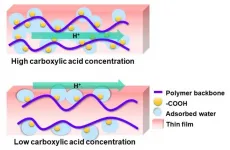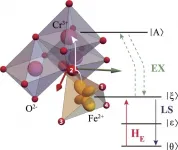Proton's travel route in polymers could lead the way to clean fuels
Researchers explore proton transport in thin film polymers containing various concentrations of an organic acid group found in biomaterials
2021-05-28
(Press-News.org) Ishikawa, Japan - Protons--subatomic particles with a positive electric charge--are one of the first particles to have formed after the universe began and are a constituent of every atom today out there. The movement of protons plays a key role in energy conversion processes, such as photosynthesis and respiration, in biological systems. In addition, proton conduction is an important factor for hydrogen fuel cells, which are often touted as the ideal clean energy source for the next generation.
High proton conduction observed in biomaterials such as sugar and protein derivatives is attributed to the presence of proton-donating functional groups (substituents in a molecule that governs its characteristic chemical reactions). However, the exact mechanism of proton transport in these materials is not clearly understood (for instance, whether the protons prefer to flow along the biomaterial surface i.e. interfacial transport, or through the bulk). Moreover, it is not clear how the concentration of the functional group might affect proton transport pathway.
Against this backdrop, in a new study recently published in the journal Electrochemistry, a team of researchers from Japan, led by Assoc.Prof. Yuki Nagao from Japan Advanced Institute of Science and Technology (JAIST) and Athchaya Suwansoontorn, a PhD student at JAIST, as well as Assoc.Prof. Katsuhiro Yamamoto from Nagoya Institute of Technology, Prof. Shusaku Nagano from Rikkyo University and Prof. Jun Matsui from Yamagata University, set out to explore how proton conduction was affected in styrene-based polymers with the change in the concentration of carboxylic acid, a proton-donating organic acid found commonly in biomaterials. Suwansoontorn lays out the motivation for their research: "The study of proton transport pathways is fundamentally important to elucidate the functioning of many biological systems."
The research team systematically synthesized polymers with different concentrations of carboxylic acid and prepared them as thin films with high surface-to-bulk ratio to enable investigation of interfacial transport properties. Following this, they characterized the polymer structures using a variety of standard characterization techniques.
The research team observed the presence of two kinds of carboxylic acid groups (COOH) in the polymers: free COOH groups, which were more abundant at higher concentrations, and cyclic dimer COOH groups, which were prevalent at low concentrations. To correlate this with proton transport, the researchers examined in-plane proton conduction using impedance spectroscopy and calculated the interfacial resistance to gauge the possibility of interfacial transport.
They found that a high COOH concentration was more conducive to internal proton transport while lower concentrations favored interfacial transport. They attributed this to the presence of free COOH groups at high concentrations that generated more hydrogen bonding networks, facilitating proton conduction. Furthermore, they verified this idea by showing that a higher number of free COOH groups on the interface led to higher interfacial conduction.
"Our research may contribute to developing bio-conductive materials for biological devices involved with proton conduction and eco-friendly fuel cells," says Suwansoontorn, contemplating the practical ramifications of the findings. "From a broader perspective, it can facilitate people's lives by supporting biological technologies and green energy application development."
To combat climate change, greener energy is the need of the hour. In that context, the findings of this study promise some exciting consequences to look forward to, for sure!
INFORMATION:
Reference
Title of original paper: "Interfacial and internal proton conduction of weak-acid functionalized styrene-based copolymer with various carboxylic acid concentrations"
Journal: Electrochemistry
DOI: 10.5796/electrochemistry.21-00042
Funding information:
This study was funded by research funding from JSPS KAKENHI Grant Number JP18K05257, JP21H00020, and JP21H01997.
About Japan Advanced Institute of Science and Technology, Japan
Founded in 1990 in Ishikawa prefecture, the Japan Advanced Institute of Science and Technology (JAIST) was the first independent national graduate school in Japan. Now, after 30 years of steady progress, JAIST has become one of Japan's top-ranking universities. JAIST counts with multiple satellite campuses and strives to foster capable leaders with a state-of-the-art education system where diversity is key; about 40% of its alumni are international students. The university has a unique style of graduate education based on a carefully designed coursework-oriented curriculum to ensure that its students have a solid foundation on which to carry out cutting-edge research. JAIST also works closely both with local and overseas communities by promoting industry-academia collaborative research.
About Associate Professor Yuki Nagao from Japan Advanced Institute of Science and Technology, Japan
Dr. Yuki Nagao is an Associate Professor at the Japan Advanced Institute of Science and Technology, Japan since 2012. He obtained his B.S. and M.S. from University of Tsukuba, Japan in 2001 and 2003, respectively and his Ph.D. from Kyushu University, Japan in 2006. He specializes in designing polymer materials conducive to interface proton transport with a focus on developing proton batteries and fuel cells. He has published over 100 papers with over 1400 citations to his credit. For more information about his research, visit: https://www.jaist.ac.jp/english/areas/mc/laboratory/nagao.html
[Attachments] See images for this press release:

ELSE PRESS RELEASES FROM THIS DATE:
2021-05-28
ITHACA, N.Y. - A Cornell University-developed technology provides beekeepers, consumers and farmers with an antidote for deadly pesticides, which kill wild bees and cause beekeepers to lose around a third of their hives every year on average.
An early version of the technology ¬- which detoxified a widely-used group of insecticides called organophosphates - is described in a new study, "Pollen-Inspired Enzymatic Microparticles to Reduce Organophosphate Toxicity in Managed Pollinators," published in Nature Food. The antidote delivery method has now been adapted to effectively ...
2021-05-28
The authors, Kirill Vasin and Mikhail Eremin, contribute to the theory of electronic and structural properties of FeCr2O4 ferrimagnet. Due to the specific quantum state and the symmetry of FeO4 fragment, it has unusual electric and magnetic properties. Below TOO~150K, it lowers the symmetry with the macroscopic deformations due to the cooperative Jahn-Teller effect. The coupling between macroscopic deformation of the crystal FeCr2O4 and its inner ions shifts was revealed. The team enhanced the microscopic crystal field theory for 3D electrons with Kleiner's correction - the effect of penetrating charges density. It allows to have better prediction of electron-deformation ...
2021-05-28
In a paper published in NANO, the author reviewed many kinds of nanofibrous filters including the component, preparation process, and application performances to provide directional guidance for improvement of the air purification field.
Poor air quality is worldwide recognized as one of five health risks for causing adverse impacts on human health. Nanofibrous membrane is competitive to capture unclean nanoparticles since its lightweight, small diameter, high specific surface area, and easy to combine with functional additives. However, the trade-off between high filtration efficiency and low pressure drop posts challenge.
The removal mechanisms of fibrous filters to nanoparticles follow ...
2021-05-28
How to construct the dual emission nitrogen-doped carbon dots (CDs) by a simple method? Professor Lili Ren with her collaborators proposed a new strategy to prepare such materials which were used to the detection of dopamine.
The traditional ratiometric fluorescence (FL) probe usually needs to combine different nanomaterials by chemical or physical methods and the manufacturing process is more complicated. While the dual-emission carbon dots (DECDs) can simplify the detection process. Therefore, it is of great significance to design a simple ratiometric fluorescence probe based on the DECDs for the accurate determination of DA concentration. ...
2021-05-28
Singapore University of Technology and Design (SUTD) researchers have uncovered how the environment can impact highly sensitive quantum behaviours like localisation. Their findings, published in Chaos, could lead to future innovations in the design of superconducting materials and quantum devices, including super precise sensors.
Quantum technology, in particular quantum sensing, promises to measure and capture our world at levels of precision never before possible. Such precision has diverse applications, from speedier and more sensitive medical imaging to recording time on high-frequency ...
2021-05-28
In the Philippines, in the early months of the COVID-19 pandemic, there occurred a supply shortage of hydroxychloroquine and methotrexate. Limited access to medication and the life changes caused from the COVID-19 pandemic may prompt patients with rheumatoid arthritis (RA) or systemic lupus erythematosus (SLE) to experience disease flares.
The researchers investigated self-reported symptoms of disease flares among patients with rheumatoid arthritis or systemic lupus erythematosus during the COVID-19 pandemic. They collected information through online surveys from 512 patients with SLE or RA. The data included ...
2021-05-28
The Montreal Heart Institute (MHI) announces that the COLCORONA study results are published today in The Lancet Respiratory Medicine. The article, which is entitled Colchicine for community-treated patients with COVID-19 (COLCORONA): a phase 3, randomised, double-blinded, adaptive, placebo-controlled, multicentre trial, concludes that, given the lack of oral therapies available to prevent COVID-19 complications among non-hospitalized patients and the observed benefit of colchicine in patients with a PCR-confirmed diagnosis of COVID-19, this anti-inflammatory drug could be considered as a treatment for those at risk of ...
2021-05-28
Multiple scientific studies show switching completely to vaping with high-quality products has reduced health risks compared to smoking, contrary to many consumer beliefs
Study data indicates that vaping products can provide an alternative for smokers who would not otherwise quit
Review supports the important role for vaping products in Tobacco Harm Reduction
Reinforces the importance of BAT's unique consumer-centric model and how we are reducing the health impact of our business and building A Better Tomorrow™ through our multicategory approach
To mark World Vape Day, BAT has today published a comprehensive review of the scientific evidence ...
2021-05-28
In a world first, scientists from the University of Sussex have recorded blood oxygen levels in the hippocampus and provided experimental proof for why the area, commonly referred to as 'the brain's memory centre', is vulnerable to damage and degeneration, a precursor to Alzheimer's disease.
To understand why this region is so sensitive, the University of Sussex researchers, headed up by Dr Catherine Hall from the School of Psychology and Sussex Neuroscience, studied brain activity and blood flow in the hippocampus of mice. The researchers then used simulations to predict that the amount of oxygen supplied to hippocampal neurons furthest from blood vessels is only just enough for the cells to keep working normally.
Dr Catherine ...
2021-05-28
The basis for this new take on the classification was laid in 1985, when John Long attributed a fossil tooth plate to a new species, Edaphodon eyrensis. The species was named after Lake Eyre, near which the tooth was found in 1978.
Asscoiate Professor Evgeny Popov had his doubts about the attribution. However, he had to study the fossil personally to advance his theory. The opportunity presented itself during a trip to Australia in 2010. The tooth plate was stored in a museum in Adelaide, South Australia.
"I didn't plan to go there, but I was able to negotiate a temporary ...
LAST 30 PRESS RELEASES:
[Press-News.org] Proton's travel route in polymers could lead the way to clean fuels
Researchers explore proton transport in thin film polymers containing various concentrations of an organic acid group found in biomaterials



